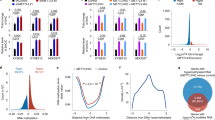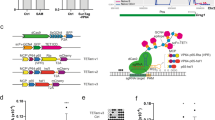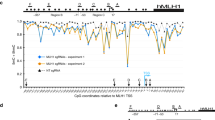Abstract
Genome-wide studies have defined cell type–specific patterns of DNA methylation1 that are important for regulating gene expression in both normal development2 and disease3. However, determining the functional significance of specific methylation events remains challenging, owing to the lack of methods for removing such modifications in a targeted manner. Here we describe an approach for efficient targeted demethylation of specific CpGs in human cells using fusions of engineered transcription activator–like effector (TALE) repeat arrays and the TET1 hydroxylase catalytic domain. Using these TALE-TET1 fusions, we demonstrate that modification of critical methylated promoter CpG positions can lead to substantial increases in the expression of endogenous human genes. Our results delineate a strategy for understanding the functional significance of specific CpG methylation marks in the context of endogenous gene loci and validate programmable DNA demethylation reagents with potential utility for research and therapeutic applications.
This is a preview of subscription content, access via your institution
Access options
Subscribe to this journal
Receive 12 print issues and online access
$209.00 per year
only $17.42 per issue
Buy this article
- Purchase on Springer Link
- Instant access to full article PDF
Prices may be subject to local taxes which are calculated during checkout



Similar content being viewed by others
References
Jones, P.A. Functions of DNA methylation: islands, start sites, gene bodies and beyond. Nat. Rev. Genet. 13, 484–492 (2012).
Smith, Z.D. & Meissner, A. DNA methylation: roles in mammalian development. Nat. Rev. Genet. 14, 204–220 (2013).
Brena, R.M. & Costello, J.F. Genome-epigenome interactions in cancer. Hum. Mol. Genet. 16 Spec No 1, R96–R105 (2007).
Bird, A. DNA methylation patterns and epigenetic memory. Genes Dev. 16, 6–21 (2002).
Suzuki, M.M. & Bird, A. DNA methylation landscapes: provocative insights from epigenomics. Nat. Rev. Genet. 9, 465–476 (2008).
Reik, W., Dean, W. & Walter, J. Epigenetic reprogramming in mammalian development. Science 293, 1089–1093 (2001).
Tahiliani, M. et al. Conversion of 5-methylcytosine to 5-hydroxymethylcytosine in mammalian DNA by MLL partner TET1. Science 324, 930–935 (2009).
Guo, J.U., Su, Y., Zhong, C., Ming, G.-L. & Song, H. Hydroxylation of 5-methylcytosine by TET1 promotes active DNA demethylation in the adult brain. Cell 145, 423–434 (2011).
Ito, S. et al. Tet proteins can convert 5-methylcytosine to 5-formylcytosine and 5-carboxylcytosine. Science 333, 1300–1303 (2011).
He, Y.F. et al. Tet-mediated formation of 5-carboxylcytosine and its excision by TDG in mammalian DNA. Science 333, 1303–1307 (2011).
Xu, Y. et al. Genome-wide regulation of 5hmC, 5mC, and gene expression by Tet1 hydroxylase in mouse embryonic stem cells. Mol. Cell 42, 451–464 (2011).
Williams, K. et al. TET1 and hydroxymethylcytosine in transcription and DNA methylation fidelity. Nature 473, 343–348 (2011).
Ito, S. et al. Role of Tet proteins in 5mC to 5hmC conversion, ES-cell self-renewal and inner cell mass specification. Nature 466, 1129–1133 (2010).
Joung, J.K. & Sander, J.D. TALENs: a widely applicable technology for targeted genome editing. Nat. Rev. Mol. Cell Biol. 14, 49–55 (2013).
Song, H.W. et al. The RHOX homeobox gene cluster is selectively expressed in human oocytes and male germ cells. Hum. Reprod. 28, 1635–1646 (2013).
Mabaera, R. et al. Developmental- and differentiation-specific patterns of human gamma- and beta-globin promoter DNA methylation. Blood 110, 1343–1352 (2007).
Maiti, A. & Drohat, A.C. Thymine DNA glycosylase can rapidly excise 5-formylcytosine and 5-carboxylcytosine: potential implications for active demethylation of CpG sites. J. Biol. Chem. 286, 35334–35338 (2011).
Miller, J.C. et al. A TALE nuclease architecture for efficient genome editing. Nat. Biotechnol. 29, 143–148 (2011).
Tan, S. et al. Zinc-finger protein-targeted gene regulation: genomewide single-gene specificity. Proc. Natl. Acad. Sci. USA 100, 11997–12002 (2003).
Mendenhall, E.M. et al. Locus-specific editing of histone modifications at endogenous enhancers. Nat. Biotechnol. doi:10.1038/nbt.2701 (8 September 2013).
Konermann, S. et al. Optical control of mammalian endogenous transcription and epigenetic states. Nature 500, 472–476 (2013).
Snowden, A.W., Gregory, P.D., Case, C.C. & Pabo, C.O. Gene-specific targeting of H3K9 methylation is sufficient for initiating repression in vivo. Curr. Biol. 12, 2159–2166 (2002).
Xu, G.L. & Bestor, T.H. Cytosine methylation targetted to pre-determined sequences. Nat. Genet. 17, 376–378 (1997).
McNamara, A.R., Hurd, P.J., Smith, A.E.F. & Ford, K.G. Characterisation of site-biased DNA methyltransferases: specificity, affinity and subsite relationships. Nucleic Acids Res. 30, 3818–3830 (2002).
Carvin, C.D., Parr, R.D. & Kladde, M.P. Site-selective in vivo targeting of cytosine-5 DNA methylation by zinc-finger proteins. Nucleic Acids Res. 31, 6493–6501 (2003).
Smith, A.E. & Ford, K.G. Specific targeting of cytosine methylation to DNA sequences in vivo. Nucleic Acids Res. 35, 740–754 (2007).
Nomura, W. & Barbas, C.F. In vivo site-specific DNA methylation with a designed sequence-enabled DNA methylase. J. Am. Chem. Soc. 129, 8676–8677 (2007).
Li, F. et al. Chimeric DNA methyltransferases target DNA methylation to specific DNA sequences and repress expression of target genes. Nucleic Acids Res. 35, 100–112 (2007).
Rivenbark, A.G. et al. Epigenetic reprogramming of cancer cells via targeted DNA methylation. Epigenetics 7, 350–360 (2012).
Siddique, A.N. et al. Targeted methylation and gene silencing of VEGF-A in human cells by using a designed Dnmt3a-Dnmt3L single-chain fusion protein with increased DNA methylation activity. J. Mol. Biol. 425, 479–491 (2013).
Reyon, D. et al. FLASH assembly of TALENs for high-throughput genome editing. Nat. Biotechnol. 30, 460–465 (2012).
Maeder, M.L. et al. Rapid “open-source” engineering of customized zinc-finger nucleases for highly efficient gene modification. Mol. Cell 31, 294–301 (2008).
Acknowledgements
This work was supported by a National Institutes of Health (NIH) Director's Pioneer Award DP1 GM105378 (to J.K.J.), NIH P50 HG005550 (to J.K.J.), NIH R01 HD053808 (to M.F.W.), NIH R01 HD045595 (to M.F.W.), NIH R01 CA169316 (to J.F.C.), NIH F32 GM105189 (to S.Q.T.), Defense Advanced Research Projects Agency (DARPA) W911NF-11-2-0056 (to J.K.J.), the Karen Osney Brownstein Endowed Chair (to J.F.C.), the Jim and Ann Orr Massachusetts General Hospital (MGH) Research Scholar Award (to J.K.J.) and a US National Science Foundation Graduate Research Fellowship (to M.L.M.). We thank the MGH Nucleic Acid Quantitation Core (supported by NIH P30 NS45776) for use of their real-time PCR machine.
Author information
Authors and Affiliations
Contributions
M.L.M., J.F.A., M.E.R., B.E.B., J.F.C., M.F.W. and J.K.J. designed experiments. M.L.M., J.F.A., M.E.R., S.J.L., V.M.C., S.Q.T., Q.H.H., J.D.S. and D.R. conducted experiments. M.L.M., J.F.A., M.E.R., B.E.B., J.F.C., M.F.W. and J.K.J. wrote the paper.
Corresponding author
Ethics declarations
Competing interests
M.L.M., J.F.A. and J.K.J. have filed a provisional patent application covering the TALE-TET fusion proteins. J.K.J. has a financial interest in Transposagen Biopharmaceuticals. J.K.J.'s interests were reviewed and are managed by Massachusetts General Hospital and Partners HealthCare in accordance with their conflict of interest policies.
Supplementary information
Supplementary Text and Figures
Supplementary Figures 1–13, Supplementary Results and Supplementary Table 2 (PDF 1825 kb)
Supplementary Table 1
Primers used in this study. All primers listed 5′ to 3′ (XLSX 12 kb)
Rights and permissions
About this article
Cite this article
Maeder, M., Angstman, J., Richardson, M. et al. Targeted DNA demethylation and activation of endogenous genes using programmable TALE-TET1 fusion proteins. Nat Biotechnol 31, 1137–1142 (2013). https://doi.org/10.1038/nbt.2726
Received:
Accepted:
Published:
Issue Date:
DOI: https://doi.org/10.1038/nbt.2726
This article is cited by
-
Genome-wide comparative methylation analysis reveals the fate of germ stem cells after surrogate production in teleost
BMC Biology (2024)
-
Genome editing in cotton: challenges and opportunities
Journal of Cotton Research (2023)
-
Targeted demethylation of the SLC5A7 promotor inhibits colorectal cancer progression
Clinical Epigenetics (2022)
-
Efficient generation of epigenetic disease model mice by epigenome editing using the piggyBac transposon system
Epigenetics & Chromatin (2022)
-
Enzyme-free targeted DNA demethylation using CRISPR–dCas9-based steric hindrance to identify DNA methylation marks causal to altered gene expression
Nature Protocols (2022)



